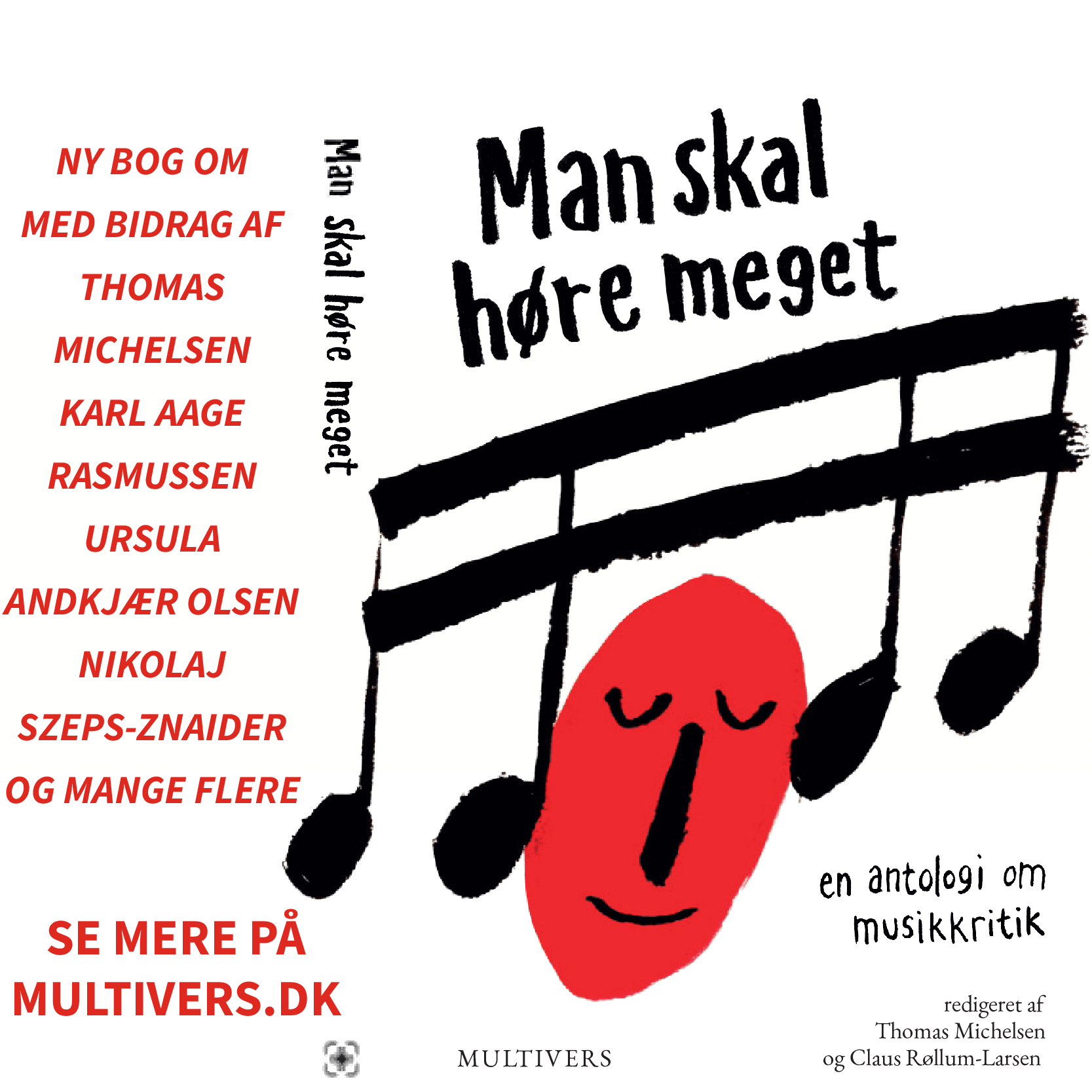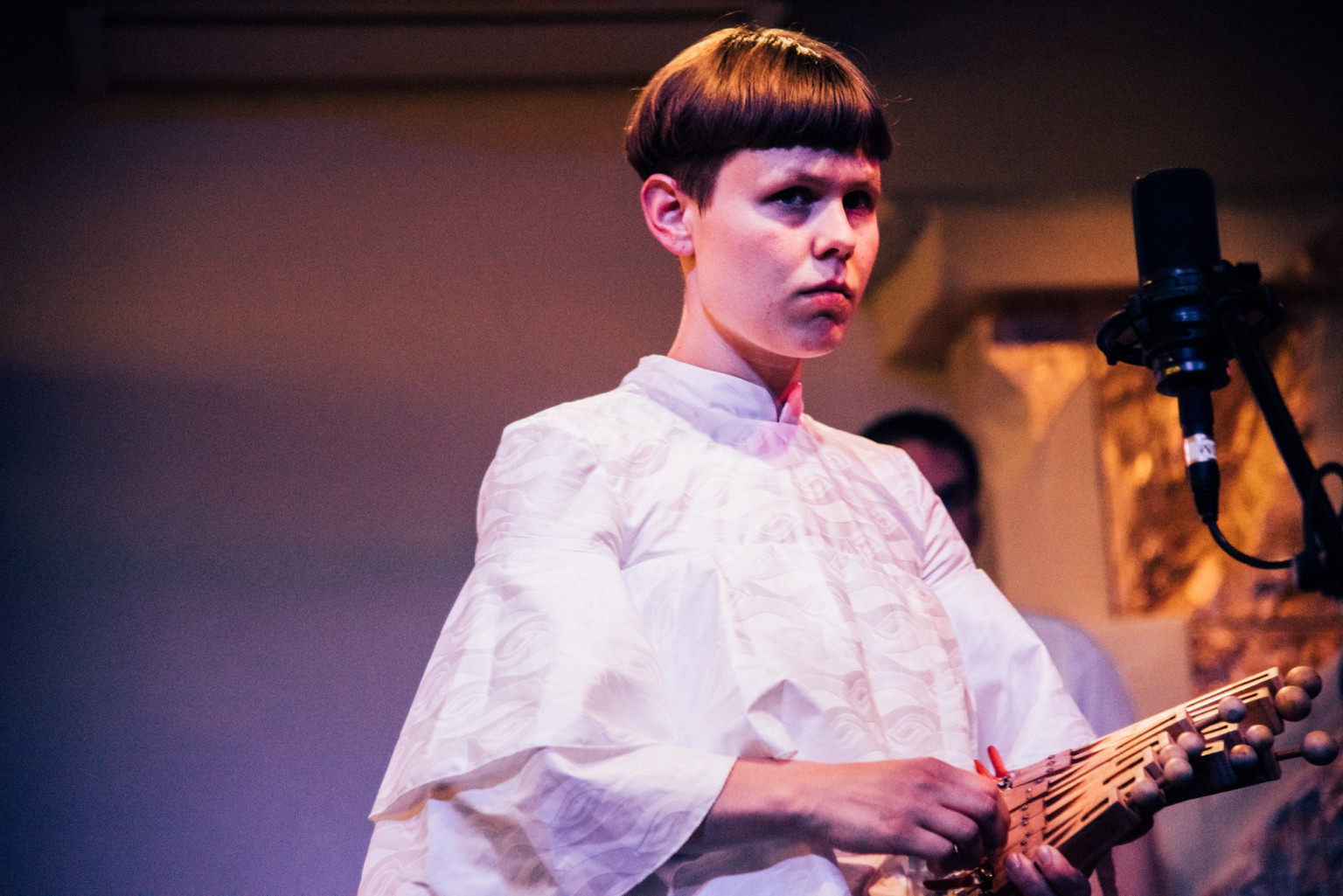
‘I need to believe it myself’
It’s hard to think of a better introduction to the world of Ragnhild May than her web shop.
On arrival, we’re greeted with a standard-looking selection of merchandise – towels, tote bags, socks – arranged in a basic web shop layout.
Everything looks professional and extremely well done, but there’s a happy weirdness bubbling under the surface
The model – May herself – exhibits the goods with a series of friendly grimaces emanating from a mouth with braces. The merchandise is embellished with slogans such as ‘Performance without Compromise’, ‘Art 4 U’, and ‘Always Good Art’.
There is a scarf on sale that costs three hundred dollars. Everything looks professional and extremely well done, but there’s a happy weirdness bubbling under the surface.
May’s tongue is firmly planted in her cheek, but if you want to buy a three-hundred-dollar scarf with ‘Ragnhild May – Kunst til dig’ [Art for you, ed.] written on it, you have the option to do so.
The play with proportion, the lack of compromise, the strong conceptual logic, the attention to detail, the bizarre humour, the canny branding – all these aspects of artist/performer/musician/composer/sculptor/who-cares/weirdo Ragnhild May are on display in her performances as well as her web shop.
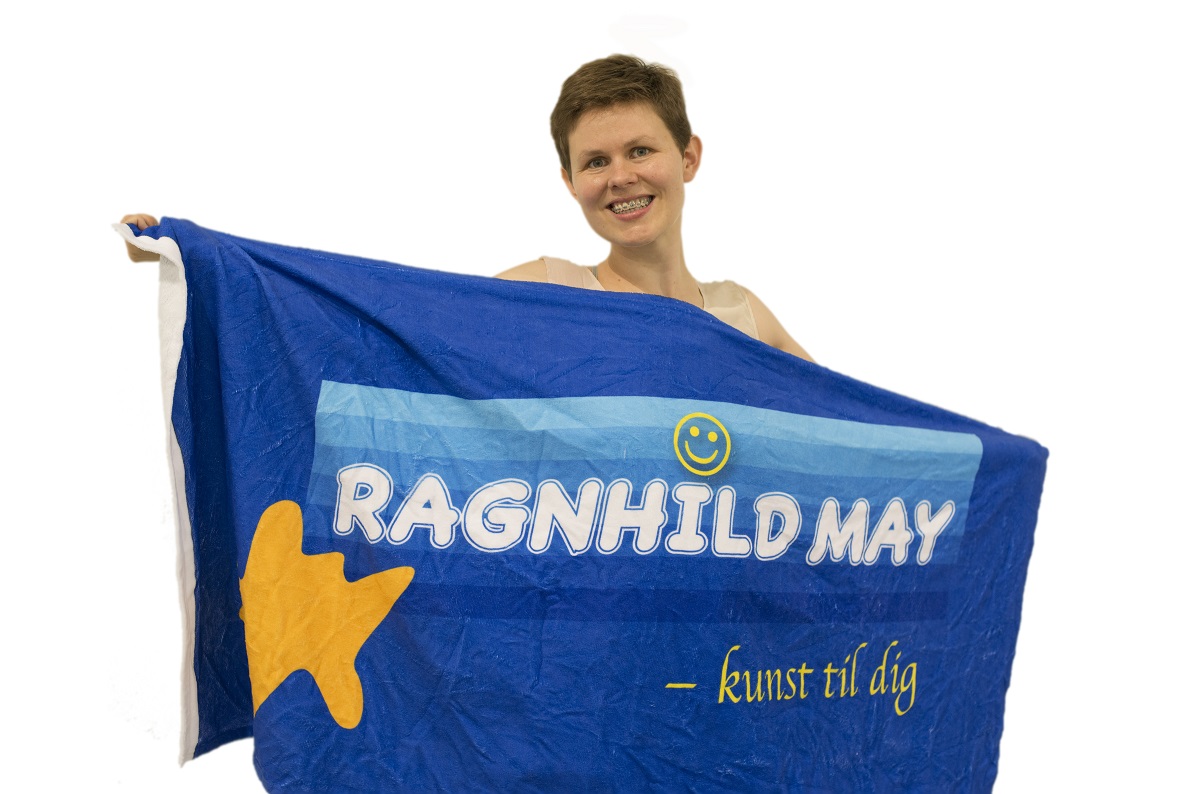 For sale in the Ragnhild May web shop. © Ragnhildmay.com
For sale in the Ragnhild May web shop. © Ragnhildmay.com
Down the aisle
I first encountered May at last year’s Young Nordic Music festival in Bergen, with a performance of her work Bellows, a collaboration with Canadian composer Stefan Maier.
The piece was a 35-minute sound meditation for organ, electronics, brass quartet and homemade instrument, exploring extremes of register and dynamics that made the entire cathedral it was played in shake.
She kneeled before the altar and vanished entirely from the audience view
But what intrigued me most about the performance was Ragnhild May herself.
Midway through, she solemnly – almost angrily – walked down the aisle, playing one of her signature homemade instruments that emitted piercingly high whistles, before she kneeled before the altar and vanished entirely from the audience view.
I got the impression of a performer who not only had an undeniably intense stage presence, but also had the savvy and self-awareness to focus her energy in surprising directions.
Yoga it is
So when it came time to choose an activity we should do together as part of this profile, the choice was fairly easy. I took her to a Kundalini yoga class at Yogacentralen in Frederiksberg.
I took her to a Kundalini yoga class at Yogacentralen in Frederiksberg
Kundalini yoga is a form of yoga based on dynamic movements and breathing exercises. A typical class consists of a series of exercises with a clear goal in mind – at the start, the teacher will normally tell you that this class will help with your digestion, or your kidneys, or seasonal affective disorder, and so on.
Everything is tightly controlled and structured, right down to the music played in the background. What often strikes me about the classes I have attended – including the one we went to – is the totally unselfconscious picking and choosing of traditions into a bizarre chimera of a yoga practice.
For example, we are told that the music comes from a long tradition dating back centuries, but it sounds like the soundtrack to a folk-revival-themed gym in 1992 staffed by particularly energetic hippies. The whole thing reminds me of a school gym class for adults, but your teacher is an ancient Indian guru.
The whole thing reminds me of a school gym class for adults, but your teacher is an ancient Indian guru
Due to the nature of the class we do not have the opportunity to speak much during, but as we go through the exercises – in this particular session, all performed seated, for some vague and mystical reason – common links with May’s work come into mind.
In both there is a strict inner logic and goal-oriented process, a process of combination and exploration of body movements, a playful and curious approach to the sensation of being human, and a connection with childhood activities.
But most importantly for me, I see in both a deeply felt inner seriousness and awareness of tradition that still allows the possibility for humour and joy.
Art outside the artist
We discuss May’s relationship with humour in the follow-up interview – conducted in two parts: the first at her studio after the yoga class, the second a couple of months later over Skype, after my laptop died and took the original interview tapes along with it.
‘It can be really mean and sarcastic, and then the next moment making fun of itself, and then be serious after that’
The theme of the court jester comes up immediately; the notion that the artist, like the court jester in medieval times, gets away with saying things that are not normally allowable due to the comic aspect of her delivery. I ask her if this idea resonates with her.
‘I identify with the court jester a lot, because you can’t really place it anywhere,’ she says. ‘It can be really mean and sarcastic, and then the next moment making fun of itself, and then be serious after that. Through the humour it can say things you aren’t allowed to say in another position.’
The jester, just like Ragnhild May, has many roles it can play beyond provocateur – as she puts it herself, ‘several horses to ride on’.
I had mentioned the court jester in my previous profile with Icelandic composer Bára Gísladóttir. With Gísladóttir, there seemed to be an emphasis on the honesty of the situation. Everything had to be real and true to life, or the work would be cheapened and robbed of its power. But May has a completely different view.
‘I think about it in a different way ... I don’t want to use the word ‘honest’ because I don’t think you can use that description about a thing, or a work. I think it has to make sense in a conceptual way.’
‘I don’t think there is such a thing as truth or honesty in a work’
‘So it’s more important to you,’ I ask, ‘that the work is conceptually solid, rather than honest or truthful?’
‘I don’t think there is such a thing as truth or honesty in a work – but I can create a logic, and the work functions within that logic.’
This is a strong contrast to both Gísladóttir and the Brazilian-born composer Marcela Lucatelli (my first profile subject in this series).
‘Still, when I work as an artist, I use a lot of my personal life’
Both of those artists speak in terms of inner life, of an almost unbreakable link between the artist and the work. But for May, the work seems to be a purely external object. I put this to her.
‘I think yes and no,’ she replies. ‘I do think about myself as Ragnhild the person, and Ragnhild the sound artist. There are different roles I can step into, and they are not all present at the same time. Still, when I work as an artist, I use a lot of my personal life – direct memories or experiences. But it’s nice to be able to step out of the artist role.’
Life as a chameleon
May has many roles she can inhabit. Her practice encompasses not only sound art and performance, but sculpture and visual art as well.
So it becomes more complicated than Ragnhild the person vs. Ragnhild the artist. We have Ragnhild the human being, Ragnhild the performer, Ragnhild the composer, Ragnhild the visual artist, Ragnhild the sculptor, and so on.
The idea of creating and then inhabiting a role is a central tenet of her practice
However, this is not to say that her focus is pulled in all these different directions. Instead, the idea of creating and then inhabiting a role is a central tenet of her practice, and something she chooses to play with.
‘I like to invent figures in my performances,’ she says. ‘I think about the clothes I wear, or about how I can represent a different ‘type’ with different connotations.’
This changes on a performance-by-performance basis. May, then, is a chameleon – able to adapt herself to new situations, and highly skilled at creating the character she wants to portray within that situation, right down to small details like outfits or physical movement.
This character-creation is not merely for the audience but for May herself. I suggest that the clothes, movements, and so on are necessary for her as a performer to fully inhabit the role she is taking on, and she agrees: ‘I’m not that good of an actor. I need to believe it myself.’
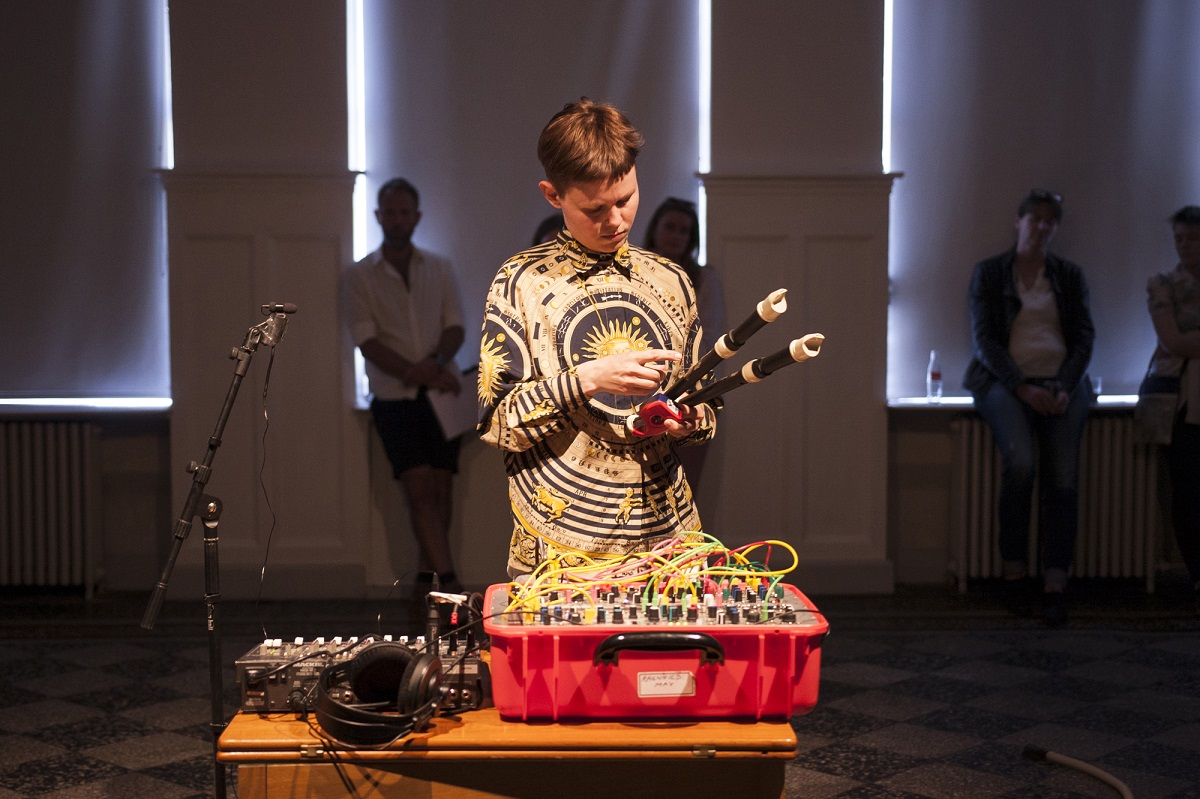 Ragnhild May at the Overgaden museum in Copenhagen in 2018. © Mette Sanggaard
Ragnhild May at the Overgaden museum in Copenhagen in 2018. © Mette Sanggaard
Playing with proportions
I have experienced the mutability of May first-hand. The second time I saw her perform was in a tiny art gallery in Valby, Copenhagen, worlds away from the grand cathedral in Bergen.
The performance, Die Sprech Maschine, was a different beast altogether than Bellows.
As with Bellows, the secret ingredient is Ragnhild May
The audience was presented with a large box connected to an air pump. Coming off the box were a series of pipes, onto which were placed recorders of all shapes and sizes.
The air from the pump was directed through the pipes according to an algorithmically generated sequence, and as a result we heard different pitches as the air was directed through the recorders.
So far, so sculpture. The above describes a static object – a pipe organ that plays itself. But, as with Bellows, the secret ingredient is Ragnhild May.
May started attaching enormous organ pipes with the use of much longer tubes
The performative aspect of the piece – which May describes as a ‘structured improvisation’ – consisted of May rearranging the recorders, or manipulating the pitches with her hands.
The instrument was also expanded live in front of us, as May started attaching enormous organ pipes with the use of much longer tubes.
It was with these larger pipes that the performance took a turn into the absurd, as the small space necessitated May walking into the audience and handing them the pipes to hold. We then didn’t hear a single sound from these pipes for several minutes, before one of them emitted a deep but quiet ‘boop’.
The performance was masterfully done and meticulously thought through and well composed and with beautiful timing and all the other things that we are supposed to say about Successful Music.
What has stuck with me about the two performances is the idea of playing with size and proportion
But what has stuck with me about the two performances is the idea of playing with size and proportion. As I said, the two venues could not have been more different from each other, and this is something May seems to make a conscious choice to play with.
The organ pipes that seemed so massive in the art gallery were just part of the ensemble in the cathedral. The handmade recorder instrument that would have been perfectly in place in the art gallery seemed miniscule in the cathedral.
Furthermore, the sound and the visual do not match up: the organ pipe in the art gallery was barely audible, but the tiny instrument in the cathedral was deafening.
Dreams of childhood
May is the Swift to the audience’s Gulliver, placing us into these situations where it is easy to lose sight of normality because our perception of scale itself is being toyed with. The interest in scale and size is tied to May’s use of personal experiences, specifically childhood.
‘There’s always this idea about childhood,’ she says. ‘It’s something all humans experience – and there are so few things that all humans experience. It binds us together in a culture.’
‘There’s always this idea about childhood. It’s something all humans experience’
More specific to Western, or even Scandinavian, culture is the common experience of making art in early school life. ‘Everybody who went to a public school probably has some experience with making clay figures in art class, or playing the recorder.’
It goes deeper than merely using objects from childhood. May is playing with the remembered experiences of being a child.
‘When you think about childhood there is this idea about a more surreal reality. It’s a bit like remembering a dream, where it’s both real and fictional at the same time and you can’t tell what you’re making up, because you’re an adult and you don’t think in the same way.’
Hence the preoccupation with proportion.
‘There’s always this question of scale. For example, when you walk into a room you haven’t been in since you were a kid and suddenly everything seems so small. There’s something you can’t really grasp between yourself and ‘the other’, on a phenomenological level.’
 Ragnhild May at the Gong Tomorrow festival in 2016. © Lars Bjarnø
Ragnhild May at the Gong Tomorrow festival in 2016. © Lars Bjarnø
The gigantic recorder
Perhaps the most obvious example of this toying with childhood memory is a sculpture by May titled Music for Children – a 2.6-metre-long, precisely scaled, presumably playable recorder.
The recorder is a recurring motif in May’s work, representing childhood encounters with music
The recorder was exhibited in the same gallery space as Die Sprech Maschine, and was accompanied by a page of ‘learn-as-you-play’ recorder method for beginners.
The sheet music, taken from a famous Danish music book, was also blown up to grotesque proportions. The only change was the notation, with all the pitches written many ledger lines below the treble clef.
The recorder is a recurring motif in May’s work, representing childhood encounters with music. When questioned on the giant recorder sculpture, May offers the following:
‘Everybody hates the recorder’
‘Everybody hates the recorder. It has this girly connotation to it as well, it has the same spectrum as a high-pitched female voice – but here scaled down to a bass singer with a low C as the main tone. There’s also this thing about women speaking – female politicians are often described as hysterical, whereas men with deep voices are seen as more serious and adult. So I scale my soprano voice down to my fiancé’s bass voice.’
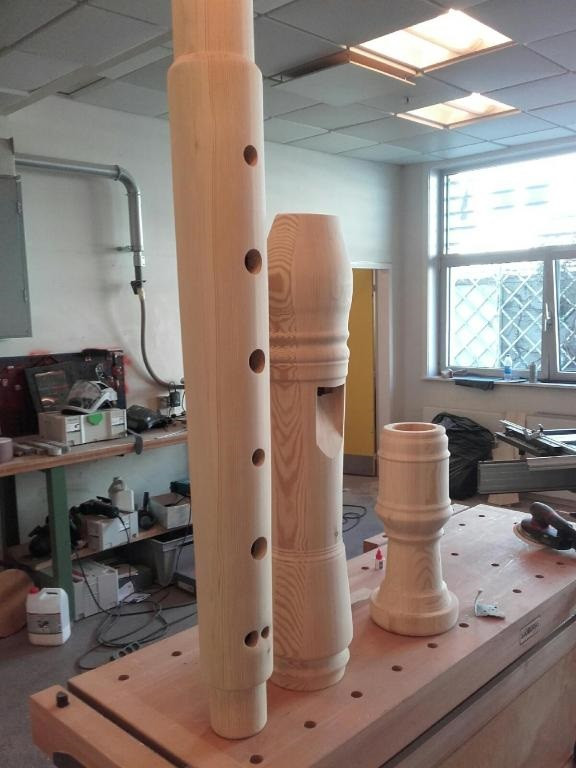
Don’t ask that question, James
At one point during the interview, I ask May the question ‘why aren’t you a composer?’. I instantly regret it for two reasons.
First, it is obvious that May is composing. On a fundamental level, she organises sound in time. The second reason is a realisation that my interview with Bára Gísladóttir pointed me towards: it does not matter.
Of the three artists I have profiled, she is seemingly the outlier
These questions of composer or performer or artist or whatever are perhaps interesting to think about in terms of cultural structures – such as performance venues, funding councils, work spaces, educational institutions, and so on – but in the day-to-day process of making or experiencing art? Irrelevant.
What, then, to make of Ragnhild May?
Of the three artists I have profiled, she is seemingly the outlier, coming from a very different educational background than the other two. And, in truth, there is a surprising difference in attitude.
May is more direct, matter-of-fact, and practical in her answers
Listening back to the interview tapes, May is more direct, matter-of-fact, and practical in her answers. She is much more focused on the immediate than the general. It’s telling that I had around four hours of material from my interview with Gísladóttir, and barely ninety minutes from May.
Whether this difference comes from her art school background – as opposed to Gísladóttir and Lucatelli studying at a conservatory – or if it is merely a matter of personality, is perhaps an uninteresting question.
Infinite ways to compose/perform
More concrete are the similarities between May, Lucatelli, and Gísladóttir. All three are performers, and they perform well – but beyond honing their craft, all three have reached the point where the craft is a means to an end, rather than the goal itself.
Good musicianship, craftsmanship, beautiful timing – all these things are present, but far more interesting is what these three artists choose to explore through their performances.
May’s machines, Lucatelli’s vocals, Gísladóttir’s double bass – these are fine experiences on their own terms. But these three artists have each figured out their own way to use their tools to engage with the stuff of being human – memory, death, apocalypse, sex, fear, anger, gender, perception, and so on.
All three have reached the point where the craft is a means to an end, rather than the goal itself
Marcela Lucatelli perhaps put it best, in a quote that didn’t make it to paper:
‘Art is a recreation on each one’s individual perspective: on the absorbed sacrifice and suffering involved in being human. Each artist has to find out where the connection is between one’s individual being and the whole being. And we have to understand some things in order to stage this – to create an environment of catharsis and sublimation. We need to choose a way of playing where this tension between ‘doing’ and ‘being’ is the most exacerbated. You have your way of staging this, I have my own.’
And May has her own, and Gísladóttir her own. There are perhaps infinite staging methods.
